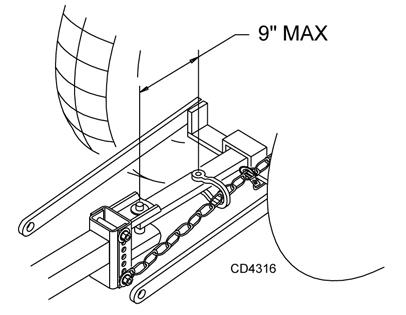
11 minute read
OPERATION
The operator is responsible for the safe operation of the cutter. The operator must be properly trained. Operators should be familiar with the cutter, the tractor, and all safety practices before starting operation. Read the safety rules and safety decals on page 5 through page 12.
This mower is designed for lawn and grass mowing. It is not designed for rough conditions or heavy weed mowing. It is equipped with suction type blades for best results in lawn mowing.
Recommended mowing speed for most conditions is from 2 to 5 mph. Always operate power unit PTO at 540 rpm.
This section provides information for attaching the mower to the tractor and preparing it for field operation. Review this data prior to tractor hook-up and operation.
Lower mower to the ground when not in use.
Full chain shielding must be installed when operating in populated areas or other areas where thrown objects could injure people or damage property.
•If this machine is not equipped with full chain shielding, operation must be stopped when anyone comes within 300 feet (92 m).
•This shielding is designed to reduce the risk of thrown objects. The mower deck and protective devices cannot prevent all objects from escaping the blade enclosure in every mowing condition. It is possible for objects to ricochet and escape, traveling as much as 300 feet (92 m).
Make sure spring-activated locking pin or collar slides freely and is seated firmly in tractor PTO spline groove.
Operate tractor PTO at 540 RPM. Do not exceed.
Stop power unit and implement immediately upon striking an obstruction. Dismount power unit, using proper procedure. Inspect and repair any damage before resuming operation.
Always wear relatively tight and belted clothing to avoid getting caught in moving parts. Wear sturdy, rough-soled work shoes and protective equipment for eyes, hair, hands, hearing, and head; and respirator or filter mask where appropriate.
Attaching Mower To Tractor
Make sure spring-activated locking pin or collar slides freely and is seated firmly in tractor PTO spline groove.
Make sure shields and guards are properly installed and in good condition. Replace if damaged.
Never attach the mower release rope to the operator, the operator's clothing, or the tractor seat.
1. Park mower and tractor on a level, hard-surfaced area.
2. Adjust tractor hitch bracket on trailer frame so the trailer is level when attached to the tractor. Pin the mower to the tractor.
Before dismounting power unit or performing any service or maintenance, follow these steps: disengage power to equipment, lower the 3-point hitch and all raised components to the ground, operate valve levers to release any hydraulic pressure, set parking brake, stop engine, remove key, and unfasten seat belt.
Never allow riders on power unit or attachment. Never allow children or untrained persons to operate equipment. Keep bystanders away from equipment.
NOTE: When attaching mower to tractor drawbar, make sure the correct drawbar pin is used. A Category 1 drawbar is 1"; Category 2 is 1.25". Failure to use the correct pin size will result in premature wear of hitch and drawbar hole. If the hitch on the mower doesn't match your tractor drawbar, contact your dealer to order the correct size hitch for your tractor. If mower will be attached to tractor for a long period of time, secure hitch to drawbar using a bolt, locknut, and washers assembled tightly. This will reduce wear on drawbar and hitch.
A 1-3/8" 6B spline PTO shaft is used for connecting the mower to the tractor. This mower is designed for 540 rpm PTO only.
The PTO drive shaft is intended for use with tractors that have 14 inches between the end of the PTO shaft and the tractor's drawbar hitch pin hole.
3. Attach the safety chain to the tractor as shown in Figure 1.
4. Attach the mower drive shaft to tractor PTO. Make sure the lock collar engages securely.
5. Attach the end of the mower’s transport lock release rope to a location on the tractor within easy reach of the operator.
NOTE: When routing the rope, do not route through the hydraulic hose guide and do not allow rope slack to drop between the driveline shields and the gearbox rotating shafts.
CV Driveline Turning Limits NOTICE
■ Do not exceed turning angle of 80 degrees at the head of the Constant Velocity (CV) driveline or damage will occur.
Check for excessive turn angle:
1. Disconnect the driveline from the tractor.
2. Start engine and turn as far right or left as possible.
3. Shut off the engine and connect the CV driveline to the tractor. If it cannot be connected, the turn angle is too severe.
4. Restart the tractor and straighten the angle slightly.
5. Shut off the engine and connect the CV driveline to tractor.
6. Repeat the process until the driveline can be connected. The point at which the driveline can be connected is the maximum turn that can be made.
Leveling Mower
Figure 1 . Tow Chain Installation
Attaching Hydraulic Hoses
1. Attach the hydraulic hose from the mower to the tractor.
2. Route the hose through the hose guide of the trailer frame and be sure the hose can slide freely in the guide. Do not allow hose slack to drag on the ground or become caught on tractor protrusions.
3. From the operator position, start the tractor, raise and lower the wings, and the rear deck several times. This will purge the hydraulic cylinders and hoses of trapped air.
Interference Check
1. Be sure that the tractor 3-point arms do not interfere with hydraulic hoses, driveline or mower frame.
2. Check for straight ahead operation and full turning angles. If there is any interference, remove the 3point arms.
NOTE: Contact between 3-point arms and mower can cause damage, especially when turning.
NOTE: To ensure satisfactory mower performance, the trailer frame and decks must be leveled before operating the mower. During normal operation, the mower should be leveled twice each season. The mower must be leveled each time a tractor with a different drawbar height is used.
Follow this procedure to level the mower for operation:
1. Park the tractor and mower on a flat level surface with the decks in mowing position.
2. Inflate all tires to the recommended pressure: 70 psi for trailer tires and 30 psi for deck gauge tires.
3. Level the trailer frame by adjusting the hitch. (See Figure 2.)
4. Remove the hitch clevis from the trailer frame and pin to the tractor drawbar.
5. Use the parking jack to adjust the trailer frame to the level position. Align the nearest hitch adjustment hole in the hitch clevis with a hole in the trailer frame.
6. Tighten the hardware to specifications in the Bolt Torque Chart on page 61. Readjust the level of the frame each time the drawbar height changes.
7. Attach the mower and the driveline to the tractor. Level the driveline by placing a bolt through the carrier bearing and the driveline height adjustment holes.
4. Set mower on the ground.
5. Retighten cap screws. This equalizes the clearance in the bolt holes.
6. Best mowing results will be obtained with front of mower level with, or slightly lower than, the rear.
7. Cutting height is controlled with front and rear caster wheel adjustment.
8. To raise rear of mower, move caster adjustment spacers under caster arms.
9. To raise front of mower, move spacers under front caster wheel arms.
Remember, measurement at location A (Figure 3) should not be less than location B and should not be over 1/2" greater than location B
Cutting Height Adjustment
Keep all persons away from operator control area while performing adjustments, service, or maintenance.
Before working underneath, carefully read Operator’s Manual instructions, disconnect driveline, raise mower, securely block up all corners with jackstands, and check stability. Secure blocking prevents equipment from dropping due to hydraulic leak down, hydraulic system failures, or mechanical component failures.
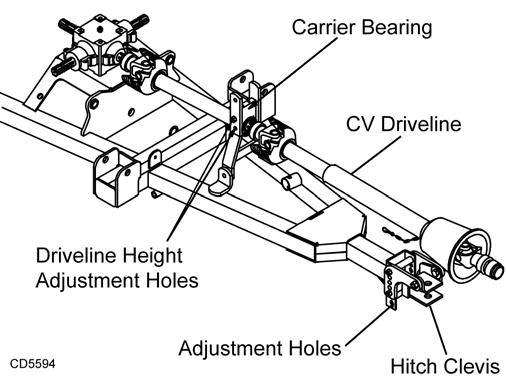
Notice
■ Avoid low cutting heights. Striking the ground with blades produces one of the most damaging shock loads a mower can encounter. Allowing blades to contact ground repeatedly will cause damage to mower and drive.
1. Level mower from side to side. Check by measuring from mower frame to the ground at each deck rail.
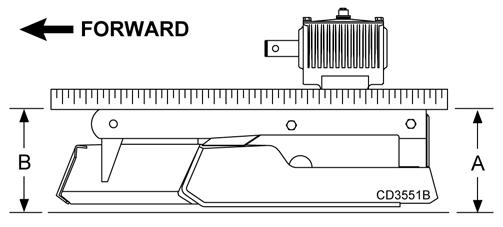
2. Verify that the same amount of spacers are under all caster arms.
3. Loosen cap screws that attach caster arm assembly to deck.
Table 1: Cutting Height Chart Spacers Required Under Caster Arm Pivot Tube
Transport
When transporting the mower short distances, raise the wings and the rear deck until all three transport locks engage automatically.
Install locking pins to secure the mower wings for transport as shown in Figure 4 and Figure 5.
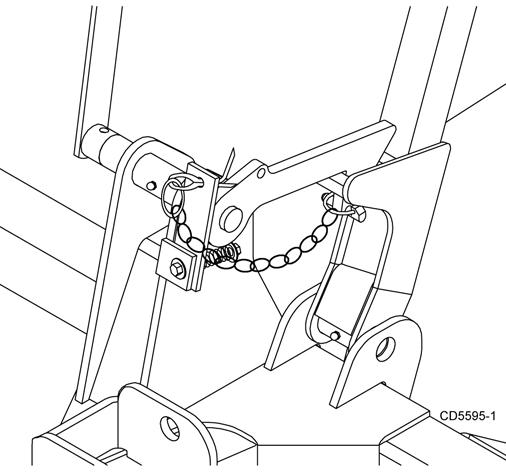
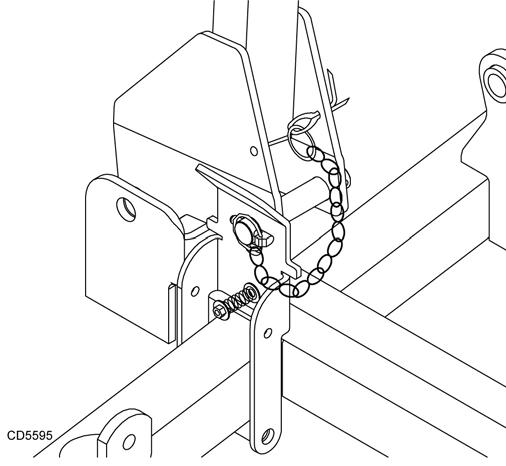
3. Pull the transport lock release rope to disengage the locks. Lower the wings and rear deck and release the rope.
Starting And Stopping Mower
Do not operate PTO during transport.
Never direct discharge toward people, animals, or property.
Keep hands, feet, hair, and clothing away from equipment while engine is running. Stay clear of all moving parts.
Stop power unit and implement immediately upon striking an obstruction. Dismount power unit, using proper procedure. Inspect and repair any damage before resuming operation.
Always sit in power unit seat when operating controls or starting engine. Securely fasten seat belt, place transmission in neutral, engage brake, and ensure all other controls are disengaged before starting power unit engine.
Notice
■ Stopping the mower with belt in contact with a very hot pulley will bake and ruin belt.
Power for operating the mower is supplied from the tractor PTO. Refer to your tractor manual for instructions on engaging and disengaging the PTO.
Operate PTO at 540 rpm. Know how to stop tractor and mower quickly in case of an emergency.
If the mower becomes plugged causing the belt to slip for over two seconds, follow these steps:
1. Raise mower just enough to clear accumulated material.
2. Continue running at least two minutes, allowing pulleys to cool.
To reduce the risk of thrown objects, do not raise the mower higher than necessary
Operating
To lower the wings and the rear deck:
1. Remove the locking pins and store in holes provided.
2. Slightly raise the wings and rear deck to take pressure off the locking mechanisms.
Do not operate mowers on terrain that raises mowers beyond 25 degrees. Exceeding this design limit will result in U-joint “knocking noise” and potential driveline failure and could cause driveline to pull apart.
When engaging the PTO, engine rpm should always be low. Once engaged and ready for mowing, increase PTO speed to 540 rpm and maintain speed throughout the cutting operation.
Mower vibration tends to loosen bolts. All hardware should be checked regularly to maintain proper torque. Each time the mower is used, check all hardware to be sure it is secure. Recommended torque values can be found on page 61.
The condition of the terrain will determine cutting results. For best results, mower blades should be kept sharp at all times and the platform as level as possible. When mower blades show excessive wear, they should be replaced.
Operating Technique
Stop power unit and implement immediately upon striking an obstruction. Dismount power unit, using proper procedure. Inspect and repair any damage before resuming operation.
Proper ground speed will depend upon the terrain, the height, type, and density of material to be cut.
Normally, ground speed will range from two to five mph. Tall dense material should be cut at a low speed; thin medium-height material can be cut at a faster ground speed.
Always operate tractor PTO at 540 rpm to maintain proper blade speed and produce a clean cut.
Under certain conditions, tractor tires may roll some grass down and prevent it from being cut at the same height as the surrounding area. When this occurs, reduce your ground speed, but maintain PTO at 540 rpm. The lower ground speed will permit grass to partially rebound.
In general, lower cutting heights give a more even cut with less tendency to leave tire tracks. However, it is better to cut grass frequently rather than too short. Short grass deteriorates rapidly in hot weather and invites weed growth during growing seasons. Follow local recommendations for the suitable cutting height in your area.
Operating Tips
Inspect and clear area of stones, branches, or other hard objects that might be thrown, causing injury or damage.
Extremely tall material should be cut twice. Set mower at a higher cutting height for the first pass. Then cut at desired height 90 degrees to the first pass.
Remember, sharp blades produce cleaner cuts and require less power.
Analyze area to be cut to determine the best procedure. Consider height and type of grass and terrain type: hilly, level, or rough.
Uneven Terrain
Do not operate or transport on steep slopes.
Do not stop, start, or change directions suddenly on slopes.
Use extreme care and reduce ground speed on slopes and rough terrain.
Watch for hidden hazards on the terrain during operation.
In extremely uneven terrain, rear wheel weights, front tractor weights and/or front tire ballast should be used to improve stability.
Pass diagonally through sharp dips and avoid sharp drops to prevent “hanging up” the tractor and the mower. Practice will improve your skills in maneuvering rough terrain.
Avoid sudden starts and stops when traveling up or down hill.
Always mow down slopes, never up or across the face. Avoid operating on steep slopes.
Slow down on sharp turns and slopes to prevent tipping and losing control.
Removing Mower From Tractor
1. Park the unit on a level, hard surface with the wings and rear deck fully lowered to the ground.
2. Block the wheels to keep the mower from rolling when unhitched from tractor.
3. Attach the jack to the side of the tongue and adjust the height to take the weight off the tractor hitch.
4. Disconnect the PTO shaft and the hydraulic hose, untie the mower transport lock release rope from the tractor, and remove the hitch pin.
5. Store the PTO shaft end and the hydraulic hose couplings off the ground and keep them clean.
PRE-OPERATION CHECK LIST (OWNER's RESPONSIBILITY)
___Review and follow all safety rules and safety decal instructions on pages 5 through 12.
___Check that all safety decals are installed and in good condition. Replace if damaged.
___Check that all shields and guards are properly installed and in good condition. Replace if damaged.
___Check that chain shielding is in good condition and replace any damaged chain links.
___Check that all hardware and cotter pins are properly installed and secured.
___Check to ensure blades are sharp, in good condition, and installed correctly. Replace if damaged.
___Check that equipment is properly and securely attached to tractor.
___Make sure driveline spring-activated locking pin or collar slides freely and is seated firmly in tractor PTO spline groove.
___Make sure the driveline guards and tether chains are in good condition. Guards must rotate freely on driveline. Fasten tether chains as instructed to the tractor and the equipment.
___Inspect area and remove stones, branches or other hard objects that might be thrown, causing injury or damage.
___Do not allow riders.
___Check all lubrication points and grease as instructed in Lubrication Information, page 20. Make sure the PTO slip joint is lubricated and that the gearbox fluid levels are correct.
___Check that all hydraulic hoses and fittings are in good condition and not leaking before starting tractor. Check that hoses are not twisted, bent sharply, kinked, frayed or pulled tight. Replace any damaged hoses immediately.
___Make sure tractor ROPS or ROPS cab and seat belt are in good condition. Keep seat belt securely fastened during operation.
___Before starting engine, operator must be in tractor seat with seat belt fastened. Place transmission in neutral or park, engage brake and disengage tractor PTO.







